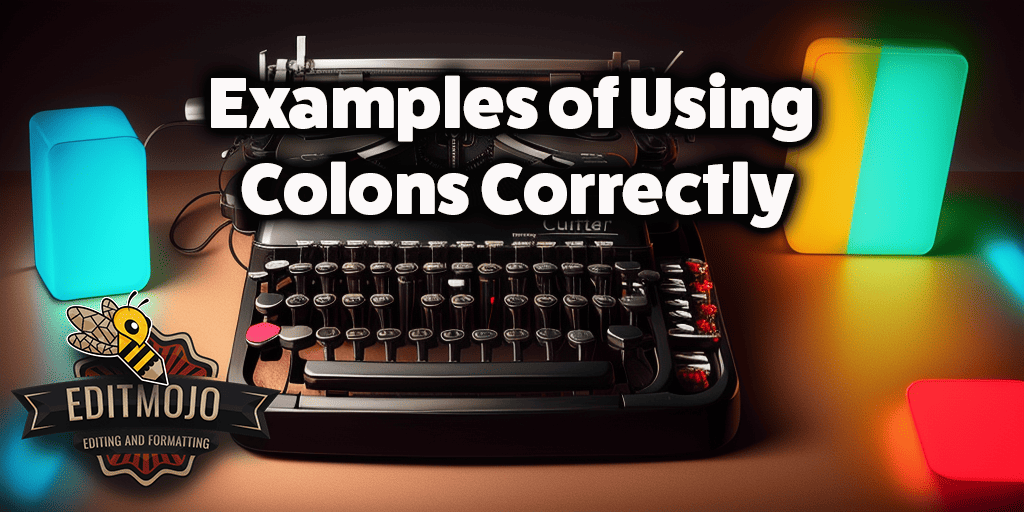Examples of using colons correctly
Examples of using colons correctly. Have you ever felt daunted by the colon’s dual-faced nature, its ability to both separate and unite elements in a sentence? It’s a powerful piece of punctuation, but its misuse can potentially turn your well-intentioned phrases into a jumble of confusion. Fear not, because today we’re going to explore the depths of the colon, offering up illustrative and practical examples of using colons correctly.
Key takeaway:
| Use of Colon | Example |
|---|---|
| Introducing a List | She has three pets: a cat, a dog, and a parrot. |
| Introducing a Quotation | Shakespeare once wrote: “All the world’s a stage.” |
| Explaining Cause and Effect | She couldn’t sleep: she was too excited about the trip. |
| Adding Dramatic Effect | After all the hard work, it was finally here: graduation day. |
| In Ratios | The ratio of apples to oranges was 3:2. |
| In Time | The meeting is scheduled for 11:00 a.m. |
| In Dialogue (Scriptwriting) | Hamlet: “To be, or not to be, that is the question.” |
| Between Independent Clauses | I knew what I had to do: I started studying every day. |
| In Biblical References | Genesis 1:1. |
Two Dots, Infinite Possibilities: Understanding the Colon
The colon: a seemingly innocuous punctuation mark that, when used appropriately, can elevate your writing to new heights. Its main functions include introducing lists, quotes, explanations, or even to add a dramatic effect. Yet, it remains a mystery to many, as evidenced by the countless queries appearing on popular forums like Grammarly and Stack Exchange.
The List Whisperer: Colons in Listing (Grammar)
One of the most common uses of the colon is to introduce a list. When you want to enumerate a group of items in a sentence, the colon is your punctuation friend. Here’s an example:
She brought three things to the party: chips, soda, and her infectious smile.
Note that what precedes the colon must always be a complete sentence.

Quote Unquote: Colons and Quotations
A colon can also play a vital role in introducing a direct quotation, especially if it’s a substantial one. Observe:
In the words of Oscar Wilde: “Be yourself; everyone else is already taken.”
The colon sets the stage, allowing the quotation to shine brightly in its spotlight.
Cause and Effect: Colons in Explanation
When you want to elaborate on something or explain cause and effect, a colon could be your go-to punctuation mark. Here’s how you can use it:
She was overjoyed: she had finally received the promotion.
The Dramatic Pause: Colons for Effect
Finally, let’s not forget the colon’s ability to add a dash of drama to your writing.
After months of preparation, the day had finally come: it was time for the marathon.
Here, the colon creates a pause, building suspense and heightening anticipation.
Understanding and mastering the colon’s functionality can undoubtedly enhance your writing skills. Yet, remember that, like all good things, colons should be used in moderation. Overuse can make your text look cluttered and feel disjointed.

For more comprehensive guidance on punctuation, check out the Purdue Online Writing Lab, a brilliant resource with a plethora of information.
In the end, understanding the colon is all about practice and patience. So why not start now? Go on, sprinkle some colons in your next piece of writing, and watch as they transform your sentences into vibrant expressions of thought and meaning.
Embrace the colon: it’s more than just two dots on your page.
A Deeper Dive: Expanding on the Colon’s Capabilities
After exploring the basics, it’s time to delve deeper into the colon’s abilities and nuances. This punctuation mark is not only functional but also adds a stylistic flair to your writing when used aptly.
The Ratio Rationale: Colons in Mathematics
Yes, you read that right. The colon isn’t just for writers — it’s a mathematician’s friend too! In mathematics, a colon often represents a ratio. For instance, when you say the ratio of girls to boys in a class is 3:2, you are effectively using a colon to represent this relationship.
Time is of the Essence: Colons in Time
In everyday life, you probably use colons more frequently than you realize. Every time you glance at a digital clock, there it is. The colon separates hours from minutes, and minutes from seconds.
The train departs at 09:45.
Scriptwriting Star: Colons in Dialogue
In scripts and plays, colons often introduce dialogue, dictating who says what:
Juliet: “O Romeo, Romeo, wherefore art thou Romeo?”
Advanced Use Case: Independent Clauses
While the colon is typically used to introduce something, it can also follow an independent clause – a sentence that can stand on its own – and introduce another related independent clause.
She knew what she had to do: it was time to confront him.

Biblical Reference: Colons in Citations
The colon has an important role in biblical references where it separates chapter and verse:
John 3:16.
The colon, as we can see, is a versatile tool and it finds utility in various fields and contexts.
To delve deeper into the world of punctuation, you can also consider reading “Eats, Shoots & Leaves” by Lynne Truss, a highly engaging book on the subject. You can find it on Amazon.
So, take a moment to appreciate the humble colon: the unsung hero of punctuation that has been contributing quietly to the clarity and coherence of our written communication. Remember, mastering punctuation is an art, and the colon is a vital part of your toolkit.
The colon: discover its power, harness its potential, and watch your writing flourish.
Writing Resources (Colon Usage Examples):
- Different Types of Fruit: apples, oranges, bananas, pears, peaches.
- Animals in the Zoo: lions, tigers, elephants, giraffes, zebras.
- Common Metals: gold, silver, copper, aluminum, iron.
- U.S. States on the East Coast: New York, Florida, Georgia, Virginia, Massachusetts.
- Capital Cities in Europe: Paris, France; Madrid, Spain; Rome, Italy; Berlin, Germany; London, United Kingdom.
- Famous Painters: Van Gogh: Starry Night, Sunflowers; Da Vinci: Mona Lisa, The Last Supper; Picasso: Guernica, The Weeping Woman.
- Top Universities: USA: Harvard, MIT, Stanford; UK: Oxford, Cambridge; Canada: University of Toronto, McGill.
- Ingredients for a Salad: Lettuce: romaine, iceberg, spinach; Dressing: vinaigrette, ranch, blue cheese; Add-ons: croutons, cheese, nuts.
- Books and Authors: “1984”: George Orwell; “To Kill a Mockingbird”: Harper Lee; “The Catcher in the Rye”: J.D. Salinger.
- Movie Genres: Comedy: “Superbad”, “Bridesmaids”; Drama: “The Shawshank Redemption”, “The Godfather”; Horror: “The Conjuring”, “Get Out”.
- Olympic Sports: Summer: Athletics, Swimming, Gymnastics; Winter: Skiing, Ice Hockey, Figure Skating.
- Elements of a Story: Characters: protagonist, antagonist; Plot: conflict, resolution; Setting: time, place.
- Types of Clothing: Formal: suits, tuxedos; Casual: jeans, t-shirts; Athletic: sweatpants, jerseys.
- Common Professions: Medical: doctor, nurse, pharmacist; Education: teacher, principal, counselor; Engineering: civil engineer, mechanical engineer, software engineer.
- Periods in History: Ancient: Roman Empire, Greek Civilization; Medieval: The Dark Ages, The Renaissance; Modern: The Industrial Revolution, The Information Age.
